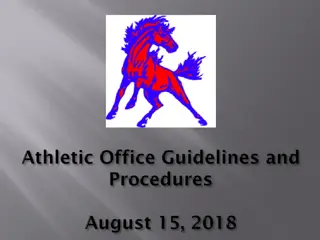Dizziness
Gain organized knowledge on various clinical presentations of dizziness and learn how to interpret clinical findings for accurate diagnosis and management. Explore common cognitive biases in dizziness management. Treat dizziness effectively.
Uploaded on Dec 21, 2023 | 2 Views
Download Presentation

Please find below an Image/Link to download the presentation.
The content on the website is provided AS IS for your information and personal use only. It may not be sold, licensed, or shared on other websites without obtaining consent from the author. Download presentation by click this link. If you encounter any issues during the download, it is possible that the publisher has removed the file from their server.
E N D
Presentation Transcript
Learning objectives Gain organised knowledge in the subject area dizziness Be able to correctly interpret clinical findings in patients with vertigo Know and apply the relevant evidence and/or guidelines to different clinical presentations of dizziness Be aware of common cognitive biases in the diagnosis and management of dizziness
Outline Dizziness is very common Older can have more than one type of dizziness A common AMU dilemma is distinguishing peripheral from central causes of vertigo In vertigo, pattern recognition followed by proper examination of eye movements is key Dizziness is treatable!
Scenario 1 A 75 year old woman presented following a fall, she sustained a fractured wrist She said she bent over to put her shoes on when she experienced a few moments of everything moving and she keeled over This has never happened before Bloods, clinical exam, ECG, L+S BP all normal
Scenario 2 A 70 year old man has had three episodes of syncope in the last 12 months, after the last one his GP stopped his doxazosin Since the last collapse when he bumped his head he feels his balance is wrong , he tends to veer to one side when walking Bloods, clinical exam, ECG, L+S BP, CT head all normal
Scenario 3 A 40 year old man presented after several hours of vertigo, he has had this twice before in the last 12 months He had no focal neurological symptoms or signs at any time On examination, eye movements, cranial n s, general neurological exam, gait and balance were all normal
Scenario 4 A 60 year old man presented with vertigo, vomiting and ataxia, he is now back to normal The clerk-in noted he experienced left arm numbness for 10 minutes during the attack On examination he was back to normal and eye movements, cranial n s, general neurological exam, gait and balance were all normal A colleague has diagnosed viral labyrinthitis (proper term: vestibular neuritis)
Scenario 5 A 25 year old footballer woke up feeling a bit dizzy . On his way to work he started to feel disequilibrium while walking and by the time he got to work he had severe vertigo, ataxia and vomiting. On examination he had spontaneous horizontal nystagmus (with a slight rotational component) to the right. When he walked he veered to the left. The head thrust test was abnormal on the left. The rest of the neurological examination was normal
Knowledge gaps is the main reason for diagnostic error in dizziness
Simplified dizzy tree Disequilibrium Lightheaded Vertigo Unrelated to posture 1 Cardiac 2 Anxiety or stress Postural 1 OH 1 Uncompensated vestibular disorder 2 BPPV 3 MFDE 4 Neurological disorders Single attack of prolonged vertigo 1 Vestibular neuritis 2 Stroke Recurrent attacks 1 BPPV 2 Migraine 3 Meniere s
Facts n figures 1 Causes of acute and recurrent vertigo % of all vertigo in primary care % of all vertigo in specialist clinics BPPV (common) 40% 10-27% Vestibular neuritis (common) 40% 10-44% Migraine (probably common) 14% 7-10% Meniere s (uncommon) Debatable 3-11% Stroke (uncommon) Not available Not available Cerebello-pontine tumours (rare) Not available <1% Barraclough K and Bronstein A. Vertigo. BMJ 2009; 339: 749-52
Facts n figures 2 Diagnosis of vertigo in the Emergency Department (by neuro-otologists) Diagnosis % of cases BPPV Vestibular neuritis Migrainous vertigo Anxiety Stroke Pre-syncope 31 28 12 11 4 4 Cutfield NJ, Seemungal BM, Millington H, Bronstein AM. Diagnosis of acute vertigo in the Emergency Department. Emerg Med J 2011; 28: 538-9
How common is dizziness in older people? 120 Prevalence per 1000 people 100 80 Male 60 Female 40 20 0 65-74 yrs 75-84 yrs 85+ yrs Marsingh et al. Dizziness reported by elderly patients in family practice: prevalence, incidence, and clinical characteristics. BMC Family Practice 2010; 11:2
Mini-tutorial: eye movements in vertigo Standard neurological and ENT examination is often negative in dizzy patients
Examination of eye movements: look for 1. Primary gaze / spontaneous nystagmus Ask patient to fix gaze on a clearly visible object ahead 2. Gaze-evoked nystagmus Take a fixation target (eg your pen) 30 degrees to the right, left, up and down, at an average fixation distance of 30cm* 3. Pursuit Repeat the above and look for jerky eye movements. Saccadic (jerky) pursuit indicates a central lesion but is a normal finding in old age 4. A normal or abnormal head-thrust test Ask patient to fix gaze on your nose, or an object just behind you, and keep their eyes on the target while you move their head briskly 30 degrees to the right, then left 5. (Positional nystagmus) Observe for any and what type of nystagmus during a Hallpike Manoeuvre
Peripheral vs central nystagmus Horizontal (with a torsional component) Fast component away from the affected side Does not change direction with direction of gaze Inhibited by fixation Head impulse test abnormal on affected side Fades after a few days Vertical, horizontal or torsional Fast component towards the affected side May change direction with direction of gaze Not inhibited by fixation Head impulse test normal Lasts weeks or months
Simplified dizzy tree Disequilibrium Lightheaded Vertigo Unrelated to posture 1 Cardiac 2 Anxiety or stress Postural 1 OH 1 Uncompensated vestibular disorder 2 BPPV 3 MFDE 4 Neurological disorders Single attack of prolonged vertigo 1 Vestibular neuritis 2 Stroke Recurrent attacks 1 BPPV 2 Migraine 3 Meniere s
Single attack of prolonged vertigo: red flags Focal neurological symptoms or signs at any time Abnormal eye movements not consistent with acute unilateral vestibular failure Acute hearing loss Headache
Watch: https://youtu.be/1q-VTKPweuk Demonstration of the HINTS exam
Vestibular neuritis or neuronitis (a.k.a. acute unilateral peripheral vestibulopathy) History Acute onset, often on waking 25% experience a gradual onset over several hours and some experience warnings a day or two before Oscillopsia, n&v, veering to one side, head movement makes things worse No focal neurological symptoms at any time 50% patients have a preceding respiratory tract infection Examination Signs of acute unilateral vestibular failure and nothing else: 1. Veering towards the affected side 2. Spontaneous horizontal nystagmus (with a torsional component) away from the affected side 3. Abnormal head thrust test on the affected side
Resolution of eye signs in acute vestibular neuritis Acute stage Sub-acute stage
What would do you do in this situation? A previously independent 80 year old lady presented to ED with acute onset vertigo and unsteadiness that morning. There were no other symptoms at any time. Her past medical history included hypertension, type 2 diabetes and a previous myocardial infarction. She could no longer mobilise independently. The standard neurological examination was normal. Examination of her eye movements showed horizontal gaze evoked nystagmus that changed direction with direction of gaze and did not improve with visual fixation, saccadic pursuit, a normal head thrust test and a negative Hallpike Manoeuvre on both sides. Her CT head was normal.
Abnormal eye movements in different types of stroke Site of infarct Nystagmus Other findings Partial AICA (labyrinth) Identical to vestibular neuritis (ie horizontal-torsional towards healthy side) Abnormal head thrust test but profound hearing loss Complete AICA As above plus gaze-evoked nystagmus towards lesion As above plus Horner s, facial paralysis, saccadic pursuit, ipsilateral limb ataxia One vestibular nucleus Purely torsional towards healthy side Skew deviation, saccadic pursuit Brainstem at the root entry of the vestibular nerve Identical to vestibular neuritis Hearing symptoms, hemi- ataxia, Horner s PICA Identical to vestibular neuritis plus gaze-evoked nystagmus towards lesion Wallenberg s syndrome Cerebellar Gaze-evoked nystagmus Limb and/or truncal ataxia
Single episode of prolonged vertigo: summary The key question is whether the vertigo is peripheral (inner ear) or central (brain) in origin. A patient with clear brainstem or limb symptoms (at any time), any red flags, or abnormal eye movements apart from a peripheral vestibular nystagmus has a central disorder until proven otherwise.
Any questions at this point?
Simplified dizzy tree Disequilibrium Lightheaded Vertigo Unrelated to posture 1 Cardiac 2 Anxiety or stress Postural 1 OH 1 Uncompensated vestibular disorder 2 BPPV 3 MFDE 4 Neurological disorders Single attack of prolonged vertigo 1 Vestibular neuritis 2 Stroke Recurrent attacks 1 BPPV 2 Migraine 3 Meniere s
Benign Paroxysmal Positional Vertigo Affects almost 1:10 older people, women twice as much as men A range of symptoms: Brief vertigo with certain head movements Disequilibrium: My balance is wrong. More prolonged dizziness can occur A range of consequences: Falls, fractures Loss of independence Very treatable! cochlea
Migrainous vertigo (a.k.a. vestibular migraine) not the same as basilar migraine Proposed criteria for migrainous vertigo: A. Episodic vestibular symptoms B. Migraine according to the IHS criteria C. At least one of the following migrainous symptoms during at least two vertigo attacks: Migrainous headache Photophobia Phonophobia Visual or other auras D. Other causes ruled out by appropriate investigations Proposed criteria for probable migrainous vertigo: A. Episodic vestibular symptoms of at least moderate severity B. At least one of the following: Migraine according to the HIS criteria Migrainous symptoms during vertigo Migraine-specific triggers of vertigo Response to anti-migraine drugs C. Other causes ruled out by appropriate investigations
Menieres Disease (a.k.a. idiopathic endolymphatic hydrops) Clinical features Prevalence 0.2-2 per 1000 people cf migrainous vertigo 10 per 1000 people Recurrent attacks of vertigo with cochlear symptoms Fluctuating then progressive hearing loss Becomes bilateral in 40% of cases 40% also have BPPV Investigations and treatment Vestibular suppressants for acute attacks Low salt diet, bendroflumethiazide, surgical options, ?regular betahistine Refer ENT Driving advice www.tinnitus.org.uk
Other causes of recurrent attacks of vertigo Symptom No of patients Visual (diplopia, field defects) 29 Drop attacks 14 Do not diagnose TIAs in cases of recurrent attacks of vertigo and no other symptoms. Unsteadiness, inco-ordination 9 Extremity weakness 9 Confusion 7 Headache 6 Hearing loss 6 Loss of consciousness* 4 Grad A, Baloh RW. Vertigo of vascular origin: clinical and electronystagmographic features. Arch Neurol 1989; 46: 281-4 Extremity numbness 4 Dysarthria 4 Tinnitus 4 Peri-oral numbness 2
Any questions at this point?
Simplified dizzy tree Disequilibrium Lightheaded Vertigo Unrelated to posture 1 Cardiac 2 Anxiety or stress Postural 1 OH 1 Uncompensated vestibular disorder 2 BPPV 3 MFDE 4 Neurological disorders Single attack of prolonged vertigo 1 Vestibular neuritis 2 Stroke Recurrent attacks 1 BPPV 2 Migraine 3 Meniere s
How to take a history in dizziness 1. 2. Tell me all about your dizziness Do you feel lightheaded, or are things moving as if you have just stepped off a roundabout? Symptoms associated with the dizziness? Neurological Migraine Hearing/ears Past medical history Medication list In recurrent dizziness: any triggers and whether completely back to normal between attacks 3. 4. 5. 6.
How to examine a patient with dizziness Lying and standing BP, pulse Watch the patient walk Neurological examination including cranial nerves Document eye movements!! Spontaneous nystagmus Gaze-evoked nystagmus Pursuit Head-thrust test Positional nystagmus Depending on the history, an audiological examination may be required
Further reading Dizziness. A practical approach to diagnosis and management. Bronstein and Lempert (comes with videos on CD!) Cambridge University Press, 2007 Vestibular Disorders. A case-study approach to diagnosis and treatment 3rd Ed. Furman, Cass and Whitney. Oxford University Press, 2010
Any questions at this point?
Summary of Guidelines and MCQs












